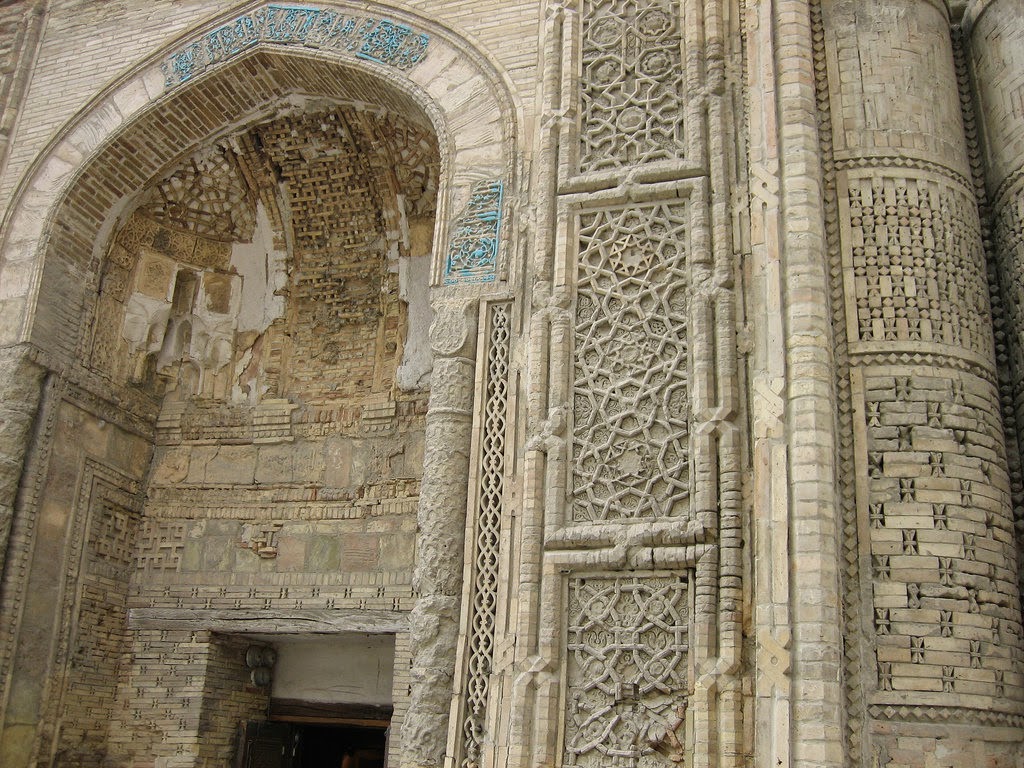Detail of the ganch wall decoration, the Throne Hall, Khudoyar Khan Palace, Kokand, Uzbekistan
Anyone who has not been to Central Asia is hardly likely to know the meaning of ganch. If one explains what ganch is it may seem highly prosaic: it is neither stone nor clay but something in between. It is obtained by firing a rock containing gypsum and clay and grinding it into a powder which is then mixed with water and a solution of vegetable glue. It then slowly solidifies as it dries out. Its shades range from light gray to light yellow. Ganch carving is one of the unique and ancient forms of artistic crafts of Central Asia.
Ganch decorated ceiling, Khudoyar Khan Palace, Kokand, Uzbekistan
The history of this craft dates back to the 3rd-4th centuries when in the Khorezm Palace of Toprak-kal a whole hall of large statues decorated in ganch were crafted. In 5th-7th centuries sculptural compositions in ganch on mythological and fairytale themes embellished the Palace of Varakhsha near Bukhara. In the 9th-10th centuries relief carving on flat surfaces became highly popular. It can be seen in the decor of the Mausoleum of the Samanids in Bukhara and in the palace of the Termez Shahs. Besides depicting lions and griffins the ganch sculptors also went in for geometrical and floral arabesques.
Ganch carving at Khudoyar Khan Palace, Kokand, Uzbekistan
Only mosques, madrasahs, the house of rich landowners and nobles were decorated with ganch but the flourishing of this art came in the 18th-19th centuries, when also the homes of the common people started to be adorned with ganch. This period is characterized by the development of methods, techniques, types of ganch carving and varieties of ornaments. At the beginning of the 20th century ganch carving on the mirror surface was created.
The basic technique of ganch carving is as following: on the white or coloured background layer of ganch the white layer is applied from one and a half to two and a half cm thick and the design's outline is cut along the ganch plaster with a sharp chisel and the pattern is cut right through the layer in such a way that the coloured background shows through the gaps. It is an intricate art that takes many years of hard work to master.
Ganch carving of Magok-I-Attari Mosque, Bukhara, Uzbekistan
Ganch carved ceiling of Hakim at-Termezi Mausoleum, Termez, Uzbekistan. Photo courtesy Nicola e Pina
Uzbek ganch carvers at work, mid.20th century. Max Penson Photography
Ganch over mirror decorated ceiling. Photo source
The basic technique of ganch carving is as following: on the white or coloured background layer of ganch the white layer is applied from one and a half to two and a half cm thick and the design's outline is cut along the ganch plaster with a sharp chisel and the pattern is cut right through the layer in such a way that the coloured background shows through the gaps. It is an intricate art that takes many years of hard work to master.







I'm enchanted! I didn't know anything about ganch before....amazing design and structures.
ReplyDeleteThey rich with the detail of design! Thank you for sharing this Olga. Somehow, sometimes I think you could be a great teacher about culture :)
ReplyDeleteHave agreat day my friend!